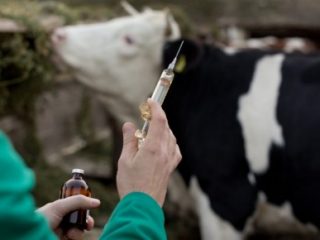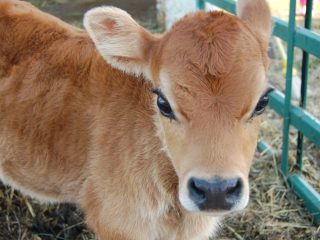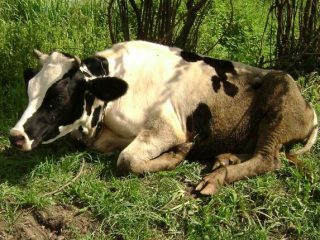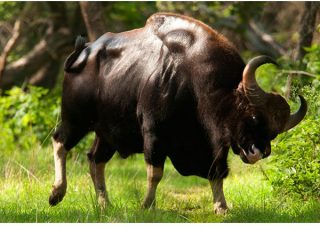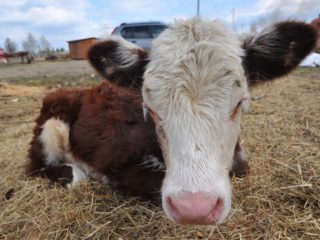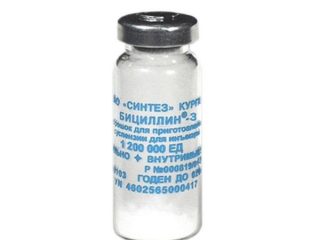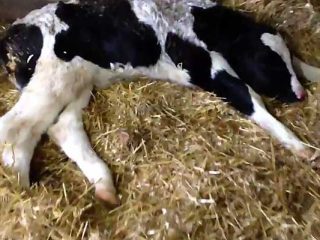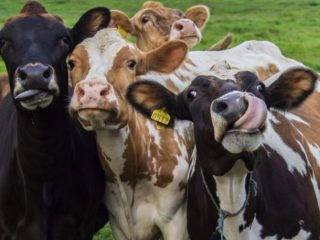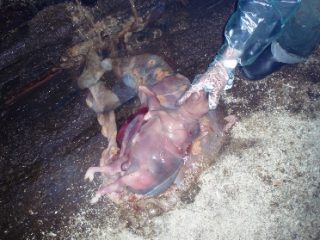Content
- 1 Pros and cons of freestall housing for cows
- 2 Free-stall cow housing technology
- 3 Equipment for loose housing of cattle
- 4 Dimensions of stall for cattle in loose housing
- 5 Features of freestall housing of cows on deep litter
- 6 Daily routine on a free-stall cattle farm
- 7 Preparing for the transition to free-stall cow keeping
- 8 Conclusion
The development of milk and meat production technologies dictates the conditions for keeping cattle. The use of machine milking machines and halls specially adapted for this process forces livestock farmers to switch to free-stall housing for cows.
Before the collapse of the USSR, even millionaire collective farms often did not have the equipment to automate the process of obtaining milk, and milking was done manually. With this method it was convenient to keep the animals on a leash. But this production method significantly increased the cost of the final product. And dairy cows produced less milk. Residents of the Union felt this well, standing in line for sour cream and receiving butter on ration cards.
Pros and cons of freestall housing for cows
The tethered option is very convenient for manual milking, as the cows remember their stall and stand in it themselves. Under the Soviet system, when each milkmaid was assigned certain cows, this was also a way to save time by not looking for “your” cows in the stall.
It is easier to carry out veterinary manipulations with tethered cattle. Each cow can be provided with an individual diet. However, in the USSR they did not think about such trifles. With tethered housing, space was saved, and there was no need to think about the behavioral characteristics of individual cows.
But even in the USSR they understood the need for movement; livestock were kept on a leash only in the barn. They were driven into the pens to “get some air” without leashes. Therefore, almost all the advantages of tethered housing, except for veterinary inspection, disappeared.
With the development of automation, approaches to keeping livestock began to change. The advantages of the untethered method outweighed its disadvantages and advantages of a tether:
- maximum automation of a dairy farm;
- reduction of required personnel;
- reducing the labor intensity of keeping livestock;
- improving the health of cows through an active lifestyle.
Herd animals have another characteristic: they feel calmer when they are in a herd. The free-stall method allows keeping livestock as close as possible to natural conditions.
But untethered content also has disadvantages:
- it is more difficult to monitor health, since a sick individual cannot always be seen in the herd;
- It is impossible to choose an individual diet for each cow.
The latter is still not popular in Russia, and this circumstance cannot be seriously considered a disadvantage.There is another serious disadvantage to the introduction of free-stall housing in Russia: the lack of specialists who understand this method.
An attempt to independently introduce free-stall livestock keeping on existing farms leads to the situation in the photographs below.
Both in one and the other photo are an attempt to independently organize the free-stall keeping of a herd. Result: “we wanted the best, but it turned out as always.”
Free-stall cow housing technology
Free content can be:
- boxed;
- combibox;
- on deep litter.
The difference between the first two lies in the location of the feeders.
In all cases, the dairy herd also requires the construction or separate equipment of a milking parlor. Free-stall housing technology dairy cows is not as simple as it might seem at first glance.
Fattening bulls can simply be kept in a pen. In a warm region, a light shelter from rain, wind or sun will be enough for them. The premises for dairy cattle are equipped so that the cows go directly from the main premises to the dairy shop. Dairy cattle spend most of their time indoors. And equipping a free-stall dairy farm is not just about putting up 4 walls and putting them under a roof. For the same reason, old cowsheds cannot be converted to new principles, although farmers claim that even in this case, milk yield increases.
In the literature you can find the opinion that cows in cubicles do not need bedding. But if the owner requires a clean and healthy udder in his animal, then bedding is required.
Bedding material
In the West, various materials are used for bedding for cows:
- straw;
- sawdust;
- sand;
- paper;
- processed manure.
In Russia, only the first two types are most common.
Straw is an almost ideal bedding material. It passes slurry well and is easy to process into fertilizer. But contaminated straw bedding becomes an ideal breeding ground for bacteria that cause mastitis. The straw “bed” is thoroughly cleaned once a month and refilled every day.
Sawdust, like straw, absorbs liquid well and is easy to use and store. Disadvantage: fresh sawdust may be too wet, which will also lead to the growth of pathogenic bacteria.
Sand, when used correctly, is very economical. Replacement is required every six months. It prevents the development of pathogenic bacteria. The sand provides the cow with good traction on the floor. Requires less storage space than straw. The downside is high transportation costs. It is also not fully understood how sand interacts with slurry.
Paper is more suitable for free-keeping chickens. Its use in animal husbandry is not recommended:
- coated does not absorb liquid well, and the cows lie in dampness;
- gets dirty quickly;
- there is a very great need for highly absorbent cuttings made from newsprint;
- cows tend to eat bedding.
Since old printed materials are usually used as litter, such paper contains a large amount of lead. The only advantage of paper is that it is often sold treated with antibacterial drugs.
Processed manure is currently only used in England and Scotland. The material is new and not well studied. Not recommended for use in calving areas or as bedding for calves.
Equipment for loose housing of cattle
In the case of tethered housing, the cow stands with her head to the feeder, and her croup above the ditch for collecting manure. If the equipment is in good working order, a conveyor belt passes through this groove, with the help of which the manure is removed. In a critical situation, cleaning the stall can be done manually.
With loose housing, this will not work, since the cattle move freely. This means that mixing of excrement and heavy contamination of the farm is inevitable. Accordingly, farms are built immediately with the expectation of free-stall housing. This applies primarily to the floor and communications under it. The rest can indeed be equipped in old barns. This is an old principle: building a house begins with laying a sewer system.
Floor
The sewage system on the farm is a conveyor belt laid under the floor. The gutter, like the conveyor belt, should be across the entire width of the free space. Since the floor in this case is made of iron gratings, the cows push excrement through the holes onto the conveyor belt. Then either the manure travels along a conveyor into the pit, or rots under the floor for six months before harvesting.
The latter is undesirable, as it guarantees a stink and a large number of flies. And urine will quickly rust the iron of the gratings.
Second option: cow boxes with bedding and bare concrete or rubber floors in the aisles. This floor can be easily cleaned with a mini bulldozer and washed with a hose. But drains must also be laid for water and urine.
Feeders and boxes
Equipment for free-stall combi-box housing of cows differs from box housing only in the location of the feeders. With box feeding, the feeders are located on the opposite side of the passage. With combiboxing, they are combined with stalls for cows.
When keeping cows in free-stall boxes, you need to make three passes: two between feeders and stalls and one dispensing one. In a warm region, you can take the feeders outside under a canopy, then there will be no need for a dispensing passage indoors.
With a combibox, the feeder is located close to the stall. That is, the cow eats in the same place where it lies down to rest. Behind her is a common space for the entire herd. In this case, there is only one “working” passage: the dispensing passage.
Dimensions of stall for cattle in loose housing
If there are a very large number of cows, the herd is divided into sections in loose housing. Each section contains 30-50 heads. For rest, cows are equipped with boxes measuring 2.0 x 1.1 m. In fact, these are the same stalls that are used for tethered housing, but there are no fastenings for chains in these boxes.
When kept in a box, the passage between the feeder and the box should be 3 m wide. A “bath” for rest is made taking into account the fact that bedding can fall on the floor.
A “bath” is made either one for everyone, or a separate one for each box. In the second case, cleaning the dirty litter will be very inconvenient. The edges of the “bath” should be 15-20 cm higher than the passages. Bedding material is poured into the resulting container.
On Russian farms, in order to save money, they often practice keeping cows in loose stalls without bedding. But with such housing, there is a high probability of mastitis due to cold and injuries when the cow lies down on the bare floor.
With a large number of livestock, groups in sections are formed taking into account age and physiological condition. Cows are divided into:
- new-born;
- milch;
- deadwood.
It is also undesirable to place very young and old individuals together. The young are looking for their place in the hierarchy of the herd, and the old are often no longer able to fight back.
Features of freestall housing of cows on deep litter
It is advisable to keep cows on deep bedding in regions with a large amount of cheap straw. But with such content there are certain nuances. The principle of deep bedding for livestock was transferred to livestock farming from horse breeding. This is an old English method of keeping horses.
The nuance is that deep litter is not just a large amount of straw piled in the room. When kept on a deep bed of straw, a mattress is made using a special technology. There are no specialists in Russia capable of laying straw correctly yet.
There is another point. A cow is a very “wet” animal. She produces more urine than a horse. Cattle manure is also semi-liquid. This makes it very difficult to keep cattle on a straw mattress. If when caring for a horse it is enough to pick up apples and cover the bedding on top with fresh straw, then when keeping a cow you will have to remove the entire top layer. If the cattle are kept free-stall, they mix the straw and spread the manure on the bedding.
There are recommendations to remove the straw mattress 1-2 times a year also “came” from horse breeding. When keeping cows, this operation will have to be carried out at least once every 3 months. Or more often.
A straw mattress has a significant advantage: thanks to the bacteria remaining on the straw, under the influence of decomposing urine, the straw begins to rot. After six months or a year, ready-made fertilizer is obtained from it.But a large number of bacteria also turns out to be a disadvantage: when straw is contaminated, they provoke the development of mastitis in cows.
If the bedding is always clean, mastitis almost never happens. But if cows are forced to lie down on a dirty “bed,” then more than 50% develop infectious mastitis.
Sawdust litter
Private owners keep cows on sawdust using special bacteria. The technology requires that the layer of sawdust be 40 cm. This is quite consistent with keeping it on deep litter. But owner reviews are often negative. They claim that in winter the bacteria actually work and keep the litter dry and warm. But in the spring, cattle may well “float.”
The advertisement claims that the litter lasts for 3 years and during this time it turns into ready-made fertilizer. The reasons why the “bed” liquefies in the first spring are unknown. The only answer from managers: the technology is broken.
Feeding areas for free-stall housing on deep litter
In a common housing area, the aft part is made separately on a walking area or in a special compartment of the building. In this place, feeders for succulent food are installed. Hay and straw are fed through grates. You cannot simply place the roll in the feeding area, as in the photo below. The animals will spread the hay in an even layer on the floor and will not eat.
Special fences are made for the rolls, which will not allow the cows to spread the feed throughout the compartment. It is advisable to arrange a feeding area either indoors or under a canopy. Feeding hay and straw outdoors in bad weather will lead to unnecessary losses. Concentrates are dispensed in the milking section directly during milking.
Milking compartment
Milking areas are equipped in the same way for all types of free-stall housing. The design of the platform depends on the type of milking installation. But the main requirement: cows come to the site directly from the residential section. On small farms, small milking units are installed directly in the sections for housing dairy cows. In this case, there is no need to arrange a separate room.
Disadvantages of keeping on deep litter
In horse breeding, this method has only continuous advantages: the labor intensity of care is reduced and after six months the owner receives ready-made fertilizer. In livestock farming everything is more complicated. Since the cow's manure is semi-liquid, and she mixes it with straw, the bedding becomes dirty very quickly. Observations have established that cows stand on dirty bedding more often than lie down. In such cases, they prefer to lie down on a cleaner, but concrete floor. In addition, cattle are not able to maintain a standing position for a long time. As a result, cold floors cause colds.
Daily routine on a free-stall cattle farm
Animals easily get used to any daily routine and here you need to adapt to the staff, and not to the cows. Rough feed for cattle should be freely available at all times. Juicy ones are given throughout the day. It is better to give concentrates during milking in order to develop positive reflexes in the animal. But the feed distribution time on each farm may vary. Morning milking usually takes place from 6 to 8 am. Her time depends entirely on the schedule that the farm owner wants to see.
When milking twice a day, the next time the cows are released into the installation at 18-20 hours. With three times a day, the intervals between milkings should be 8 hours.
Preparing for the transition to free-stall cow keeping
When switching to free-stall housing for cows, it will be cheaper to demolish old buildings and put new ones in their place. But this is provided that everything is done according to technology, and not “as always.” During reconstruction, only the walls and roof will remain of the farm building.
Building
The old floor is completely removed and wide conveyor belts are laid under it. The tapes are laid at a depth of about 30 cm below the floor level. It is not worth making a manure storage facility directly under the floor. Rotting excrement releases too many harmful substances, which will affect the health of both animals and staff. Lattice flooring is made on top of the tapes.
Next, on the site of the future boxes, “baths” for lying down will be installed. Boxes are not just dividing pipes. These pipes are made foldable so that when cleaning, a mini-bulldozer can drive into the “bathtub” and rake up the dirty litter. On modern farms, not only the boxes are automated, but also the milking machines. The second stage is training or recruiting new personnel.
Staff
In loose housing, automation is used to reduce the number of personnel. To work on such a farm, staff must be able to use a computer. If the farm is large, then all operations are fully automated, and working the old fashioned way will no longer work. From an organizational point of view, this is the most difficult part of the work, since, most likely, the farm staff will have to be completely changed.
Sections
When filling the barn, the age of the animals and climatic conditions are taken into account. The entire barn can be divided into sections for animals of different ages. The required space is calculated based on size and age:
- calf up to 12 months – 2.5 m²;
- young cow 1-2 years old – from 3 m²;
- adult animal – from 5 m².
If the herd spends most of its time indoors, then the area for one adult is increased to 7 m². You can allocate more space, but you must take into account that livestock live indoors if the barn is located in a cold region. Heating is usually not done on farms, since animals are able to heat the room with their own heat. If the barn is too large and there are not enough animals, the barn will be very cold in winter.
Livestock selection
It is better to start the transition to free-stall housing with young animals or cows accustomed to the herd. Animals establish their own hierarchy. When keeping young animals together, it is established in games and in the future the “revision” of its place in the herd takes place with fewer injuries or without them at all. When gathering adult animals into a herd, serious fights are possible, including piercing the peritoneum with horns.
To avoid the latter situation, it is better to initially purchase polled cattle or dehorn calves in the first days of life. If there is nothing to choose from and the cows are horned, approximately 3 cm of the horns will have to be sawed off before the animals are released into the herd.
Cows perceive changes in an already established group as painful and reduce milk yield. Unless absolutely necessary, it is better not to introduce a new individual into an already established group.
Such conditions were often practiced on collective farms: during the day, livestock were free-range in a paddock, and at night they were tied up inside the farm premises. Hierarchy in the herd of cows was successfully established during the daytime in pens.Considering the difficulties in rebuilding old buildings to meet new standards, this combined maintenance method may still be relevant today.
It should also be taken into account that in the West, automation of farms began not because of progressiveness and technical development, but because of the high cost of manual labor. It is better to spend money on automatic systems and put one person to care for 2000 cows than to pay 100 employees. In Russia, manual labor is cheaper. Before automating a farm, you need to calculate what will be more profitable.
Conclusion
Free-stall housing of cows is a promising direction in animal husbandry. But it is most effective to build a farm immediately with this type of maintenance in mind. Rebuilding is very difficult, almost impossible.









